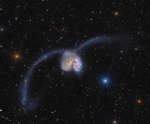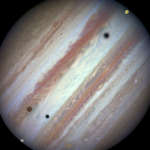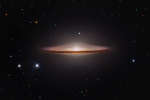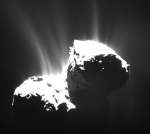
|
Astronomy Picture Of the Day (APOD)
 Exploring the Antennae
Exploring the Antennae
11.02.2015
Some 60 million light-years away in the southerly constellation Corvus, two large galaxies are colliding. The stars in the two galaxies, cataloged as NGC 4038 and NGC 4039, very rarely collide in the course of the ponderous cataclysm, lasting hundreds of millions of years.
 M100: A Grand Design Spiral Galaxy
M100: A Grand Design Spiral Galaxy
10.02.2015
Majestic on a truly cosmic scale, M100 is appropriately known as a grand design spiral galaxy. It is a large galaxy of over 100 billion stars with well-defined spiral arms that is similar to our own Milky Way Galaxy.
 An Extremely Long Filament on the Sun
An Extremely Long Filament on the Sun
9.02.2015
Yesterday, the Sun exhibited one of the longest filaments ever recorded. It may still be there today. Visible as the dark streak just below the center in the featured image, the enormous filament extended across the face of the Sun a distance even longer than the Sun's radius -- over 700,000 kilometers.
 Layered Rocks near Mount Sharp on Mars
Layered Rocks near Mount Sharp on Mars
8.02.2015
What caused these Martian rocks to be layered? The leading hypothesis is an ancient Martian lake that kept evaporating and refilling over 10 million years -- but has now remained dry and empty of water for billions of years.
 Carina Nebula Dust Pillar
Carina Nebula Dust Pillar
7.02.2015
This cosmic pillar of gas and dust is nearly two light-years wide. The structure lies within one of our galaxy's largest star forming regions, the Carina Nebula, shining in southern skies at a distance of about 7,500 light-years.
 An Aurora of Marbles
An Aurora of Marbles
6.02.2015
It looks like a fine collection of aggies. But this grid of embedded swirls and streaks actually follows the dramatic development of planet Earth's auroral substorms. The sequence of over 600 horizon-to-horizon fisheye images was taken over a 2 hour period near the artic circle in March of 2012 from Lapland, northern Sweden.
 Jupiter Triple Moon Conjunction
Jupiter Triple Moon Conjunction
5.02.2015
Our solar system's ruling giant planet Jupiter and 3 of its 4 large Galilean moons are captured in this single Hubble snapshot from January 24. Crossing in front of Jupiter's banded cloud tops Europa, Callisto, and Io are framed from lower left to upper right in a rare triple-moon conjunction.
 M104: The Sombrero Galaxy
M104: The Sombrero Galaxy
4.02.2015
The striking spiral galaxy M104 is famous for its nearly edge-on profile featuring a broad ring of obscuring dust lanes. Seen in silhouette against an extensive bulge of stars, the swath of cosmic dust lends a broad brimmed hat-like appearance to the galaxy suggesting the more popular moniker, The Sombrero Galaxy.
3.02.2015
What are those red streaks in the sky? While photographing unexpected auroras over a distant thunderstorm, something extraordinary happened: red sprites. This brief instance of rarely imaged high-altitude lightning flashed so bright that it was witnessed by several people independently.
 Jets from Comet Churyumov Gerasimenko
Jets from Comet Churyumov Gerasimenko
2.02.2015
Where do comet tails come from? Although it is common knowledge that comet tails and comas originate from comet nuclei, exactly how that happens is an active topic of research. One of the best...
|
January February March April May June July August September October November December |
|||||||||||||||||||||||||||||||||||||||||||||||||